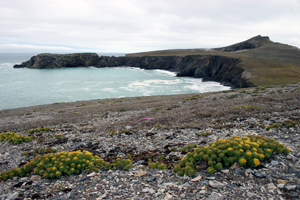Bjørnøya's vegetation
By Øystein Overrein (ed.), Jørn Henriksen, Bjørn Fossli Johansen, Kristin Prestvold
 Peat deposits on Fuglefjellet, in the south of Bjørnøya. Miseryfjellet is in the background. (Image: Hallvard Strøm / The Norwegian Polar Institute) Peat deposits on Fuglefjellet, in the south of Bjørnøya. Miseryfjellet is in the background. (Image: Hallvard Strøm / The Norwegian Polar Institute)
 Arctic roseroot in the south of Bjørnøya. The scenery to the west of Kvalrossbukta can be seen in the background. (Image: Arild Lyssand / The Governor of Svalbard) Arctic roseroot in the south of Bjørnøya. The scenery to the west of Kvalrossbukta can be seen in the background. (Image: Arild Lyssand / The Governor of Svalbard)
Bjørnøya’s vegetation belongs to the mid-Arctic tundra zone. In total, 54 of Svalbard’s 173 vascular plants have been found on the island. As for mosses, 150 species have been found on Bjørnøya and 373 in Svalbard in total. The areas by the bird cliffs are the most lush, dominated by polar scurvygrass (Cochlearia groenlandica). Elsewhere, the island gives the impression of being very unproductive. The most common types of vegetation are as follows: wetlands, with some vascular plants such as tundra grass (Dupontia pelligera), tundra buttercup (Ranunculus hyperboreus) and mountain mare’s tail (Hippuris vulgaris); wind lichen heaths, with lichens and mosses; and beach communities, with creeping saltmarsh grass (Puccinellia phryganodes), Arctic saltmarsh sedge (Carex subspathacea), polar scurvygrass and Arctic roseroot (Rhodiola arctica). There are no mountain avens heaths or sea meadows on Bjørnøya, although they are characteristic for Spitsbergen. On top of the bird cliffs in the south there are peat deposits which are several metres thick, overlying cores of ice produced by the permafrost. These layers of turf are about 9000 years old.
|